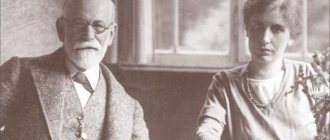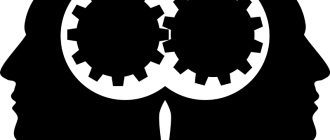Perhaps no personality theory was as widely known as psychodynamic theory (psychoanalysis), which went far beyond the boundaries of psychological science and influenced not only the development of psychology, but also sociology, medicine, culture, and art of the 20th century. Its founder was the Austrian scientist, psychoanalyst, psychiatrist and neurologist Sigmund Freud (1856 - 1939).
Freud considered the main source of personality development to be innate biological factors (instincts), which generate libido energy (attraction, desire). It is the energy of a person’s life actions and finds release in sexual behavior. According to the scientist, a complex dynamic interaction occurs between instincts and drives on the one hand and between consciousness and moral and ethical standards on the other. This interaction is regulated by human behavior. Moreover, the unconscious plays the main role in this. This explanation led to the emergence of a whole direction in the theory of personality as psychodynamic (psychoanalysis).
What is psychoanalysis
Psychoanalysis is a psychological theory and a method of psychiatric treatment based on it. The basic principles of the concept and the term “psychoanalysis” itself were created by Psychoanalysis. Encyclopaedia Britannica. Austrian psychiatrist Sigmund Freud at the turn of the 19th and 20th centuries.
Psychoanalysis was founded by McLeod S. Psychoanalysis. Simply Psychology. on the belief in the existence of unconscious thoughts, feelings, desires and memories. As a therapy, it is often used to treat depression, phobias, panic attacks, obsessive-compulsive disorder and post-traumatic stress disorder. Psychoanalysis is closely related Brenner GH What Is Psychoanalysis? Psychology Today. with psychodynamic therapy.
Also under psychoanalysis you can use Psychoanalysis. Cambridge Dictionary. understand any of a number of theories about human personality that, based on an analysis of the unconscious in the human mind, attempt to find the underlying causes of mental problems. Psychoanalysis can be described most simply. Encyclopaedia Britannica. this method as “depth psychology”.
There is no general psychoanalytic theory of treatment Safran JD Psychoanalysis Today. Psychology Today. .
More psychoanalysis is possible Brenner GH What Is Psychoanalysis? Psychology Today. considered a form of self-knowledge, a source of new spiritual experiences. If a person spends years sharing his most intimate things with someone who helps him interpret this information, he can look at himself from a completely different perspective.
And finally, psychoanalysis is often considered by Kudryashov I.S. Psychoanalysis and its prerequisites. Journal of Siberian Medical Sciences. as a scientific and philosophical concept. Freud himself believed that psychoanalysis is neither psychology nor philosophy. He called his theory metapsychological, that is, abstract, generalizing, describing psychology itself. — Approx. author. and believed that one day it would become a science. But this was not destined to come true.
In many ways, psychoanalysis was an attempt by I. S. Kudryashov. Psychoanalysis and its prerequisites. Journal of Siberian Medical Sciences. to reconcile the divergent directions in psychology of that time: philosophical and scientific. It eventually evolved into a complex set of ideas and concepts seeking an alternative answer to the question “What is man?”
Briefly about the theory
When Sigmund Freud took up psychoanalysis and presented his vision of mental problems to the world, the public received the teaching with hostility. The new theory contradicted all the canons: religion, science, philosophy, social foundations, culture. But, having originated at the end of the 19th century, the theory is still used by leading psychiatrists in the world.
The scientist dedicated his life to understanding the human psyche and identifying the components that motivate his actions. The main idea of the theory is the belief that the mental nature has no interruptions, and from one event the next is born.
It is not always possible to trace the chain of sequences. But what happened in childhood will definitely have an impact (albeit unconsciously) in later life. Freud's theory is briefly interpreted as follows: every action, desire, thought is a conscious or unconscious intention, “growing” from the past.
Note! The analyst’s task is to understand emotional experiences, find hidden connections between events and establish the true reasons for actions.
How did psychoanalysis come about?
The founder of psychoanalysis, Sigmund Freud, was born in 1856 in Austria and spent most of his life Ackerman CE Psychoanalysis: A Brief History of Freud's Psychoanalytic Theory. Positive Psychology. in Vienna. He entered medical school and trained as a neurologist in 1881. Soon he opened a private practice and began treating people with psychological disorders.
Freud's attention was drawn to a case described by his colleague, the Austrian physician and physiologist Joseph Breuer. Breuer's patient, Bertha Pappenheim, known in literature as "Anna O.", suffered from physical ailments for no apparent reason. But she felt better when Breuer helped her remember her traumatic experiences. This case will be described more than once by Freud Z. Famous cases from practice. M. 2007. Freud and other authors.
Freud became interested in the unconscious and in the 1890s, together with Breuer, began studying the state of neurotic patients under hypnosis. Colleagues came to the conclusion that the patients' condition improved when they learned through hypnosis about the real sources of their problems.
Freud also noted Psychoanalysis. Encyclopaedia Britannica. that many patients feel the effect of such therapy without hypnosis. Then he developed the technique of free association: the patient told the psychoanalyst everything that first comes to his mind when he hears words such as “mother”, “childhood”.
Freud also saw a pattern: often the most painful experiences of his patients were related to sex. He suggested that these anxious feelings were a consequence of suppressed sexual energy (libido), manifested in various symptoms. And those, according to Freud, are psychological defense mechanisms.
Using the technique of free association, Freud began to study the meaning of dreams, slips of the tongue, and forgetfulness. He considered Psychoanalysis. Psychology Today. that childhood traumas and conflicts give rise to sexual desires and aggression in a person as an adult.
The goal of Freud's psychoanalytic therapy was McLeod S. Psychoanalysis. Simply Psychology. the release of these repressed emotions and experiences, that is, an attempt to make the unconscious conscious. This healing is called “catharsis.”
Freud insisted that reducing symptoms is not enough; the problem will not be solved until its cause is eliminated.
During sessions of psychoanalytic therapy, the patient lay down McLeod S. Psychoanalysis. Simply Psychology. on a special couch, and Freud himself sat behind, taking notes. This helped both free themselves from social restrictions. To achieve a positive result, sometimes it was necessary to Ackerman CE Psychoanalysis: A Brief History of Freud's Psychoanalytic Theory. Positive Psychology. conduct two to five sessions per week for several years. Sometimes patients, according to Freud Z. Famous cases from practice. M. 2007. Freud himself, experienced memories and associations so vividly, as if they were actually returning to the past. Although, in essence, psychoanalytic therapy is just a frank conversation.
Freud's couch. Image: Robert Huffstutter/Wikimedia Commons
Resolving intrapersonal conflicts
The human psyche tries to resolve intrapersonal conflicts in various ways:
- Dreams
- Sublimation
- Compensation
- Blocking the defense mechanisms of the psyche
In dreams of desires appear that have not been realized in reality. Recurring dreams indicate dissatisfaction with a certain unrealized need , which serves as an obstacle to human freedom and development. Sublimation is understood as the redirection of internal energy to goals that are encouraged and approved in society. Especially often, these goals correspond to creative activity, socially significant acts of an intellectual nature. The author also understood sublimation as a form of successful protection ; thanks to the influence of this energy, humanity created civilization. Unsatisfied desires often cause a state of anxiety; this is the body’s ability to neutralize the problem by directly addressing it. Energy that cannot find an outlet will become focused on overcoming difficulties, reducing risks and compensating for needs. Compensation means compensation for mental deficiencies. For example, a person with a lack of ability, but with a strong desire to achieve a goal, can develop the skills of performance and assertiveness.
In some situations, the voltage may be distorted or rejected by protection mechanisms . The defensive reaction to the same situation in the psyche can be different .
For example, the reaction to unrequited love feelings can be suppression (“I don’t remember these feelings”), rejection (“I didn’t have those feelings”), rationalization (“This relationship was a mistake”), isolation (“I don’t need these feelings ") and others. In his theory, S. Freud made the greatest attempt to understand and describe the human psyche , and made sensational discoveries in the psychoanalytic direction of psychology. The basic concepts introduced by the scientist are used in science and in the modern world and are the basis of many theories.
How psychoanalysis influenced the development of psychology
During the 20th century, psychologists borrowed many of Freud's ideas and observations. This is especially true for Martynenko T.S., Deinekina A.S. The influence of psychoanalysis on modern psychotherapy. North Caucasian Psychological Bulletin. concepts of levels of consciousness, defense mechanisms and stages of psychological development.
Thus, before Freud, dreams were considered a phenomenon not worthy of scientific attention. However, his book “The Interpretation of Dreams” and the concept outlined in it aroused intense interest in this area of human life, which continues to this day.
Freud's further developments were used by Psychoanalysis. Encyclopaedia Britannica. , for example, to create the theory of child psychoanalysis. Pioneers in this area were Melanie Klein and Anna Freud, daughter of Sigmund Freud.
In a slightly different form, Freud's work was continued by Ackerman CE Psychoanalysis: A Brief History of Freud's Psychoanalytic Theory. Positive Psychology. his student Carl Jung, creator of analytical psychology. He disagreed with the teacher on the nature of libido (the energy underlying human aspirations and actions) and the unconscious, as well as the causes of human behavior.
Freud viewed libido only as a source of sexual energy, while Jung argued that it was much broader and included motives from sex to creativity.
Also, Jung did not share Freud's idea that human behavior is dictated only by past experience. He believed that future aspirations also played a significant role.
Jung's work underlies most modern psychological theories and concepts. For example, he introduced Brenner GH What Is Psychoanalysis? Psychology Today. into circulation such well-known terms as “personality archetypes” and “collective unconscious”.
In the middle of the last century, psychoanalysis entered into close interaction with the arts, humanities and philosophy. For example, he provided Elkan O. B., Putra V. A. The influence of psychoanalysis on the cinema of the twentieth century. Bulletin of Tomsk State University. Cultural studies and art history. a great influence on German expressionism, which, in turn, largely determined the emergence of the horror film genre. Freud's concept greatly influenced the work of such directors as Alfred Hitchcock, Federico Fellini, Michelangelo Antonioni, Paolo Pasolini. Freudianism also plays a significant role in the films “Basic Instinct”, “Eternal Sunshine of the Spotless Mind”, “Antichrist”, “Shutter Island”.
Look











